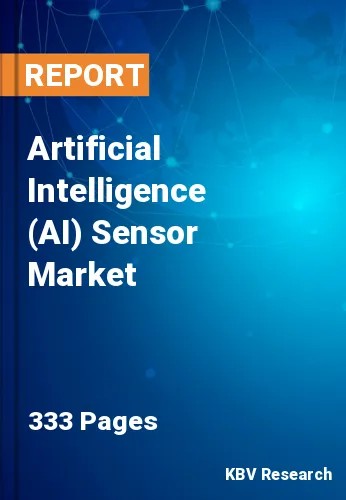
The Global Artificial Intelligence (AI) Sensor Market size is expected to reach $39.3 billion by 2030, rising at a market growth of 38.8% CAGR during the forecast period.
The demand for ultrasonic sensors is rising as these sensors are essential for proximity sensing, collision avoidance, and obstacle identification, making operations safer and more effective. Consequently, the ultrasonic segment would witness approximately 1/4th share by 2030. Numerous fatal conditions like diabetes, cancer, and others are becoming more common worldwide. 8.5% of persons 18 years of age and older had diabetes in 2014, as reported by WHO. Further, WHO states that 1.5 million deaths in 2019 were directly related to diabetes, and 48% of all diabetes-related deaths occurred in those under 70. These sensors, for instance, can be used in healthcare for non-invasive monitoring, gesture control, and imaging applications as benefits of AI becoming more prevalent.
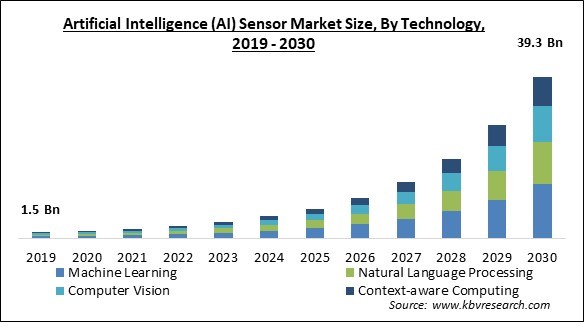
The major strategies followed by the market participants are Product Launches as the key developmental strategy to keep pace with the changing demands of end users. For instance, In January, 2023, Sensata Technologies Holdings PLC launched Sensata INSIGHTS, to decrease costs, escape problems and improve security. In addition, In May, 2021, Robert Bosch Engineering and Business Solutions, a subsidiary of Robert Bosch GmbH unveiled Phantom Edge to offer real-time electrical energy consumption, electrical parameters, operating usage, and appliance-level information.
Based on the Analysis presented in the KBV Cardinal matrix Sony Corporation and Oracle Corporation are the forerunners in the Market. In November, 2021, Oracle Corporation announced the launch of AI Services in Oracle Cloud Infrastructure (OCI) in facilitating the application of AI to improve business operations by adding new features that improve client experiences, equip staff with better information, and promote employee productivity. Companies such as Robert Bosch GmbH, Sensata Technologies Holdings PLC, Baidu, Inc., BAE Systems PLC, and RELX PLC (LexisNexis Risk Solutions, Inc.) are some of the key innovators in the Market.
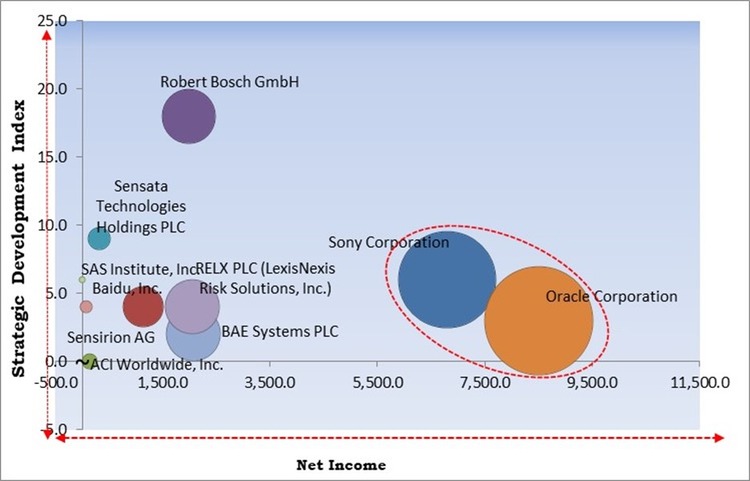
Rapid urbanization and digitization heavily impact the development of smart infrastructure. Edge computing is a vital technology used extensively in smart infrastructure. It allows for the processing and analysis of data in real time from smart sensors and other IoT devices. The demand for more sustainable and effective infrastructure solutions has increased with the growing urban population and rapid urbanization. In addition, AI and IoT technologies are necessary for developing smart cities, smart automobiles, smart traffic systems, smart homes, smart factories, and smart transport systems. As a result of all these aspects, the artificial intelligence sensor market will grow in the upcoming years.
One sector that is expanding the fastest is wearables with AI sensors. The two most significant market segments are smartwatches and ear-worn electronics. The market for AI sensors will probably rise as wearable technology becomes increasingly popular. The demand for fitness and medical tracking devices is fueling the rapid growth in wearable adoption as consumers emphasize maintaining and enhancing their overall health & wellness. These sensors are utilized in various products, including smart fabrics, headbands, neckwear, and footwear. This self-learning AI sensor will convert consumers' one-way interactions with exercise equipment into interactive training methods. In consequence, these aspects increase the demand for the AI sensors, thereby supporting the market’s expansion.
Cost is a major factor in determining the rate at which the market for AI sensors will expand. For market participants, the enormous capital requirement for implementing and maintaining integrated AI sensors may cause difficulties. The development of AI sensors is additionally expensive, which restricts the use of these sensors. Additional costs include relevant software compatibility compliances, software maintenance services, and AI sensor software solutions. Artificial intelligence is still being developed in various fields because of technological and real-world constraints that prevent it from being used in certain applications. It might hinder the market's expansion of AI sensors market.
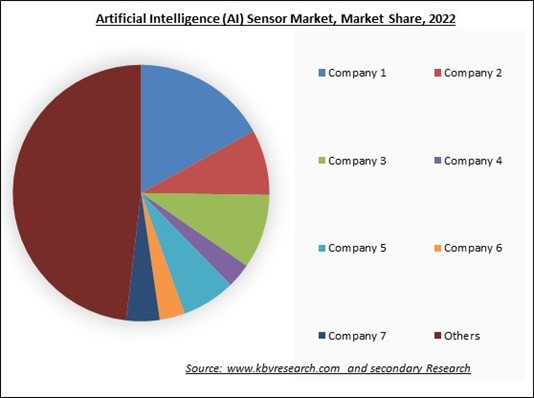
The leading players in the market are competing with diverse innovative offerings to remain competitive in the market. The above illustration shows the percentage of revenue shared by some of the leading companies in the market. The leading players of the market are adopting various strategies in order to cater demand coming from the different industries. The key developmental strategies in the market are Partnerships & Collaborations.
Based on sensor type, the market is classified into pressure, temperature, optical, position, ultrasonic, motion, navigation, and others. In 2022, the optical segment held the highest revenue share in the market. The rising need for visual data processing and analysis mostly drives growth. Optical sensors are now crucial for gathering and analysing visual data due to the growing acceptance of AI technologies and the development of applications dependent on computer vision. Optical sensors have also been widely used in many fields and applications, including consumer electronics, robotics, industrial automation, healthcare, and autonomous cars.
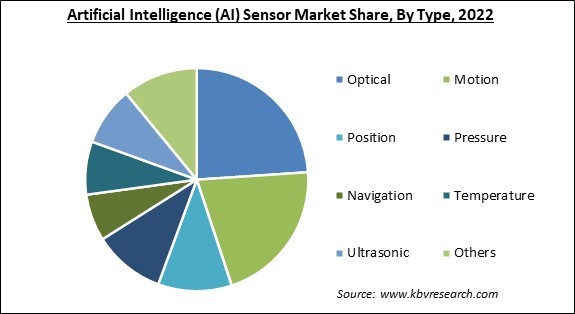
On the basis of technology, the market is segmented into NLP, machine learning, computer vision, and context-aware computing. The context-aware computing segment acquired a substantial revenue share in the market in 2022. The development of more sophisticated and precise sensors that can capture in-depth environmental data has been one of the factors behind the expansion of the context-aware computing segment. For context-aware computer systems, these sensors' ability to gather data on location, temperature, motion, light, and sound is essential.
By application, the market is categorised into automotive; consumer electronic; manufacturing; robotics, aerospace & defence; smart home automation; healthcare; and others. The consumer electronics procured a promising growth rate in the market in 2022. In consumer electronics, artificial intelligence has taken centre stage. Among the various goods & services that benefited from AI innovations, some are mobile devices, smart TVs, speakers, virtual personal assistants, and distributed and wearable sensors. The market is growing in this segment as a result of wide application of AI in consumer electronics.
| Report Attribute | Details |
|---|---|
| Market size value in 2022 | USD 3 Billion |
| Market size forecast in 2030 | USD 39.3 Billion |
| Base Year | 2022 |
| Historical Period | 2019 to 2021 |
| Forecast Period | 2023 to 2030 |
| Revenue Growth Rate | CAGR of 38.8% from 2023 to 2030 |
| Number of Pages | 333 |
| Number of Table | 453 |
| Report coverage | Market Trends, Revenue Estimation and Forecast, Segmentation Analysis, Regional and Country Breakdown, Market Share Analysis, Competitive Landscape, Companies Strategic Developments, Company Profiling |
| Segments covered | Type, Technology, Application, Region |
| Country scope | US, Canada, Mexico, Germany, UK, France, Russia, Spain, Italy, China, Japan, India, South Korea, Singapore, Malaysia, Brazil, Argentina, UAE, Saudi Arabia, South Africa, Nigeria |
| Growth Drivers |
|
| Restraints |
|
Region wise, the market is analyzed across North America, Europe, Asia Pacific, and LAMEA. In 2022, the North America region led the market by generating the highest revenue share. North America has been a notable region because of its substantial investments in R&D, robust technological infrastructure, and presence of important businesses. The market expansion of AI sensors in the United States has been significantly influenced by the presence of IT corporations and a thriving startup environment specializing in AI and sensor technologies. To influence the adoption & development of AI sensor technologies, the region has also concentrated on laws and initiatives that support moral AI and data privacy, which will boost the market expansion in this region.
Free Valuable Insights: Global Artificial Intelligence (AI) Sensor Market size to reach USD 39.3 Billion by 2030
The market research report covers the analysis of key stakeholders of the market. Key companies profiled in the report include Robert Bosch GmbH, Sensata Technologies Holdings PLC, Sony Corporation, Baidu, Inc., BAE Systems PLC, Oracle Corporation, RELX PLC (LexisNexis Risk Solutions, Inc.), Sensirion AG, ACI Worldwide, Inc. and SAS Institute, Inc.
By Type
By Technology
By Application
By Geography
The Market size is projected to reach USD 39.3 billion by 2030.
Edge computing will grow with digitalization and smart infrastructure are driving the Market in coming years, however, Rising incidence of chronic illnesses restraints the growth of the Market.
Robert Bosch GmbH, Sensata Technologies Holdings PLC, Sony Corporation, Baidu, Inc., BAE Systems PLC, Oracle Corporation, RELX PLC (LexisNexis Risk Solutions, Inc.), Sensirion AG, ACI Worldwide, Inc. and SAS Institute, Inc.
The expected CAGR of this Market is 38.8% from 2023 to 2030.
The Machine Learning segment is generating high revenue in the Market by Technology in 2022; thereby, achieving a market value of $13.3 billion by 2030.
The North America region dominated the Market by Region in 2022 and would continue to be a dominant market till 2030; thereby, achieving a market value of $13.3 billion by 2030.
Our team of dedicated experts can provide you with attractive expansion opportunities for your business.
